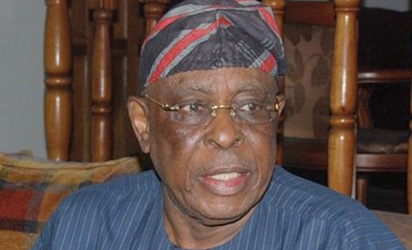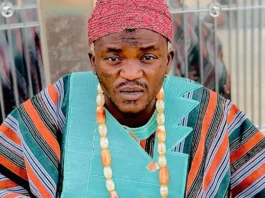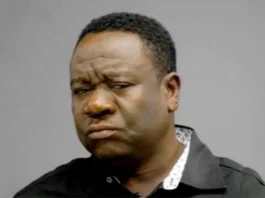
Introduction
The worth of some are weighed in gold and some are assessed in silver, yet others are priceless and inestimable. The latter category of persons is priceless because their achievements and accomplishments transcend the transient, and their impacts exceed the superficial.

Chief Olusegun Osoba
They might not have the grandest houses, the most sophisticated of the automobiles or even the most imposing of enterprises; but their ideas, their principles, their investments in people, their commitments to higher causes and their incredible prints on the sands of time, take their worth beyond rubies.
I have been privileged to meet a few of this category of persons, one of whom is today’s ‘birthday boy’, His Excellency, Chief Olusegun Osoba, CON. It was a clergy of poet, Robert South, who is reputed to have said that “if there be any truer measure of a man than by what he does, it must be by what he gives.”
It cannot be disputed, even by the most ferocious detractors, that Chief Osoba has given – he gave as a trainee reporter at Daily Times covering crime stories in 1964; he gave as a news editor when the civil war was beginning to brew more intensely in 1975 and 1984 respectively; he gave as the General Manager and Managing Director of the Nigerian Herald and Daily Times in 1975 and 1984 respectively; he gave as a member of the Nigerian Constituent Assembly in 1988; he gave as the elected Governor of Ogun State in 1992 and 1999; and today, he still gives, as an elder statesman, a sage, a human repository of the history of our people and a distinguished custodian of Yoruba culture and values.
To say I am most fascinated and enamored by the person of Chief Osoba, is to mince words – his simplicity, intelligence, carriage, sense of humour and bravery are simply amazing. Indeed, as Plato rightly noted, to measure a man, look at what he does with power. This observation is not shocking, as Lord Acton later told us, “power tends to corrupt, and absolute power corrupts absolutely. Great men are almost always bad men.”
However, Chief Osoba reveals that there are exceptions to Lord Acton’s prescient statement. It is certainly not commonplace to find a governor in Nigeria who only allotted N250, 000.00 as security vote, lived in his own house rather than the Governor’s Lodge, travelled solo for foreign trips and carried his own bag, appointed civil servants as aids rather than place more burden on the State’s limited till, never chartered an aircraft throughout his tenure and who never allowed personal disaffection with persons or corporations interfere with or taint the dispensing of his responsibility as a public officer.
We found such a State Chief Executive in His Excellency, Aremo Olusegun Osoba. Of particular interest to me is the story of how Chief Osoba allotted a prime property in Magboro to Punch Newspapers at a period when the paper was not substantially on the same wavelength with his government. So ladies and gentlemen, this is the man we have gathered to celebrate today, an unparalleled gentleman, a journalist extraordinaire and a progressive to the marrow. Allow me to therefore felicitate, most heartily, with this true son of ‘ile ojiire bi’ and a personification of the Omoluabi philosophy on this occasion of his 78th birthday. I pray that your path will keep shining brighter and brighter and for more years, nay, decades to come, you will illuminate this country and more particularly, irradiate the Yoruba with light.
May I further appreciate the Centre for Culture and Historical Awareness for organising this most propitious event and considering me worthy of facilitating same. I remain here before you knowing full well that the content of my presentation is one of utmost relevance, not just to people of this most distinguished gathering, but to the entirety of the geographical expression known as Nigeria. As such, against the background of recently escalated agitations of tribal and ethnocentric colourations, it dawned on me that if there is any time when the Yoruba nation needs a keen awareness, realisation and appreciation of who we are, what we are and where we are coming from, where we should be and where we are going, it is now.
In the midst of the resonating clamours for restructuring, the reality has struck me that without a proper construction and comprehension of who we are, then, articulating our agenda, expectations and demands within the Nigerian construct, will be next to impossible. Hence, with all solemnity, soberness and caution, I opted to discuss the topic: “Homogeneity in Heterogeneity: Redeeming the Yoruba Identity”.
My self-imposed mandate qua objective here today is quite straightforward, to wit, to help us recall our past, remember who we are as a people and thereby set a viable backdrop for subsequent discourse of what should be the Yoruba Agenda in the face of present realities.
I have therefore structured this paper, to allow us go back in time, to the days of yore when stone was the source of fire; and coming closer to contemporary times from when the cannon shots of the Royal British Navy ricocheted the hitherto tranquil coast of Eko, till when the Union Jack was eventually downed; which will then bring us to the present epoch, when the entire country is struggling for breath.
A peep at the history of the Yorubas
Ladies and Gentlemen, it was the famous proponent of black nationalism, Marcus Garvey, who said “a people without knowledge of their past history, origin and culture is like a tree without roots”. I have also heard it said, and I agree that “memories are the architecture of our identity”.
For the Yoruba people, our collective foundational memories are rooted mostly in folklore, in respect of which there are many narratives. It ia however fairly generally accepted within the circle of historians that we originally migrated from what is now known as the Middle East, particularly, from the city of Mecca. According to D. Denham, H. Clapperton, W. Oudney and A.V Salame “Yarba is an extensive province, as also a great many wonderful and extraordinary things.
In it, the talking green bird called babaga (parrot) is found. By the side of this province, there is an anchorage or harbour for the ships of Christians, who used to go there and purchase slaves.
These slaves were sold to the Christians by the people of Yarba….The inhabitants of this province (Yarba) it is supposed originated from the remnant of the children of Canaan, who were of the tribe of Nimrod.
The cause of their establishment in the West of Africa was, as it stated, in consequence of their being driven by Ya-rooba, son of Kahtan, out of Arabia to the western coast between Egypt and Abyssinia. From that spot, they advanced into the interior of Africa, till they left in every place they stopped at, a tribe of their own people.
Thus it is supposed that all the tribes of the Soudan who inhabited the mountains are originated from them as also are the inhabit ants of Ya-ory. Upon the whole, the people of Yarba are nearly of the same description as those of Noofe (Nupe).”
Further, Flora L. Shaw, an individual whose name is forever entwined with Nigeria by virtue of the fact that she reputedly coined the country’s name, enthused that the Yorubas claim to descend from the Canaanites. She espoused that “The people of Yoruba claim to descend Canaanites – that is – Phoenicians – of the tribe of Nimrod. They claim, further, that all the pagan tribes in the mountains of Hausa land descend from them because in their southward journey, they left in every place they stopped at, a tribe of their own people in the mountains.”
In a lucid, vivid and instructive analysis, she juxtaposed the Yoruba claim with the Egyptian version of the relationship with the Phoenicians, using the very early connection which existed between the valleys of the Niger and the Nile.
That is to say, making reference to the time the Phoenicians ruled in Egypt, Shaw attempted to draw out similarities and differences contained in both tales, because to her, it was easy to see how the similarity in folklore could “lead to just a tradition as that cherished by the Yoruba population of the recent day.” Of the Yoruba claim, Shaw adjudged same to be “of more than respectable antiquity.”
Redeeming the Yoruba identity (2)
Editor’s note: In the first edition of this luminous lecture by Chief Wole Olanipekun, he took us back to the dark recesses of history in the Middle East from where historians believe the Yorubas of Nigeria migrated. In this edition, we complete that ancient journey and then pay a visit to the founding fathers of USA for a lesson on how to forge a Federal Republic. Read on:
Adjunct to the above narration, the Reverend Samuel Johnson traced the origins of the Yorubas to the time of King Lamurudu, an earlier paramount of Mecca, who went on to have offspring in the persons of Oduduwa, ancestor of the Yorubas, the Kings of Gogobiri and Kukawa – two tribes in Hausa country. While Johnson admits to uncertainty about the period King Lamurudu reigned, he concedes that the progression of his descendants and their subsequent dispersal means that the period of Lamurudu’s reign must have been at a considerable time after Mahomet. He is unequivocal about somewhere in the East being the home of the Yorubas.
Hear him: “the Yorubas came originally from the east, there cannot bé the slightest doubt, as their habits, manners and customs, etc., all go to prove. With them, the East is Mecca and Mecca is the East. Having strong affinities in the East, and Mecca in the East looming so largely in their imagination, everything that comes from the East, with them, comes from Mecca, and hence it is natural to represent themselves as having hailed originally from that city.”
What is striking however, by Johnson’s own deduction, is that the name “Lamurudu (or Namurudu) is a dialectic modification of the name Nimrod…which confirms the tradition of their origin but also casts a side light on the legend…it is known that the descendants of Nimrod (Phoenicians) were led in war to Arabia, that they settled there, and from thence they were driven by a religious persecution to Africa. We have here also, the origin of the term Yoruba, from Yarba, their first permanent settlement in Africa. Yarba is the same as the Hausa term Yarriba for Yoruba.”
By the above, we find that the depictions of the Yoruba and their history by these eminent historians indicate, make clear and evince a Yoruba family branch tree reaching, from its roots in the Middle East, to its present branches the West of Africa. With that said, it becomes clear that the Yorubas are a peculiar nation, and in true Canaanite fashion, travelled many years across great distances before finally arriving at ‘home’. It is my humble view that if one were to set his imagination on the arduous task of picturing what the early Yorubas went through in their soujourn, as they journeyed through the topographies of two continents in Biblical fashion, then such a person may understand why the Yorubas are are widely believed to be made of resilient material.
I have highlighted the various historical permutations of the Yoruba origin as a precursor to discussing the topic in toto, so as to situate this conversation in its proper context. What is clear from the diverse accounts earlier considered is that whether Egba or Ijebu, Ekiti or Oyo, Awori or Egun, we have the same root, the same source and the same origin. The first message I will therefore like to impress upon us is the responsibility our commonality thrusts on us, to be united, more so at this not-too-certain times. I will consider this point further, lather in this presentation.
Contextual analysis of terms (homogeneity, heterogeneity and identity)
Having briefly considered our history as a people, it is necessary to properly define the key terms in the topic under consideration, to wit, “homogeneity”, “heterogeneity”, and “identity”. Perfunctorily, this presentation will utilize entries of this terms in the dictionary to not only excavate their definitions, but to go ahead, like John the Baptist, and shed light on the path this presentation will tread.
Merriam-Webster defines homogeneity as “quality or state of being of a similar kind or of having a similar structure or composition throughout: the quality or state of being homogenous”; heterogeneity is defined as “the quality or state of consisting of dissimilar or diverse elements: the quality or state of being heterogeneous…”, while identity is defined as sameness of essential or generic character in different instances; sameness in all that constitutes the objective reality of a thing; the distinguishing character or personality of an individual; individuality; the relation established by psychological identification; the condition of being the same with something described or asserted…”
E Pluribus Unum, which means, ‘out of many, one’ is the motto of the United States of America; and sameness serves as an apt descriptor of the ‘homogeneity in heterogeneity’ concepts. Underpinning the American motto is the constant reminder that their one federation culminated from many different parts.
It is in understanding and giving due regards to the diversity of the constituent units of the American State that the country sets the benchmark for the practice of Federalism all over the world. It is in this wise that President Ronald Reagan said “all of us need to be reminded that the Federal Government did not create the States; the States created the Federal Government”. In the Nigerian context, it was not the state that made up the country, it is the over 250 ethnicities, a key part of which is the Yoruba nation.
We did not become a people because of the contraption of the Nigerian state, we were a people before then; a people with our distinctness and peculiarities. And we have always been proud of whom we are.
An opposite exemplar of this, which in the instance, also serves as a microcosm for the Yoruba approach to life, is the truism that the living holds the commonwealth of the nation on trust for generations yet unborn. Chief Gboteyi, the Elesi of Odogbolu of blessed memory, summed this up best when he testified at the West African Land Committee (1912), that “I conceieved that land belongs to a vast family of which many are dead, few are living, and countless members are unborn.”
By extracting the utilitarian value contained in the Eleshi’s statement, and applying same to the generality of the Yorubas, a culture of conscious, deliberate and and continuous responsibility is evidenced.
The said culture has now metamorphosed, from its tribal cocoon, into a tradition widely referred as the ‘Philosophy of Iwa’. Generally, the Philosophy of Iwa is the Yoruba social mythology of existence whereby honesty, decency, rectitude, responsibility, accountability, incorruptibility, etc., are ingrained in members of the tribe as a tool of social cohesion.
It goes without saying that if all individual in a society exhibit the above virtues; such society will achieve its developmental goals due to its operating at a loftier and elevated pace. We shall consider this more robustly in the latter part of this work.












